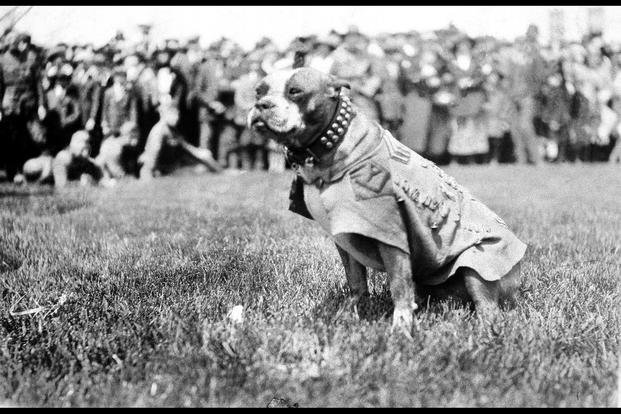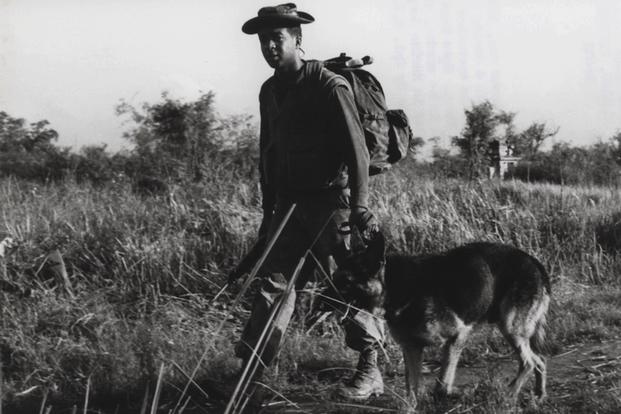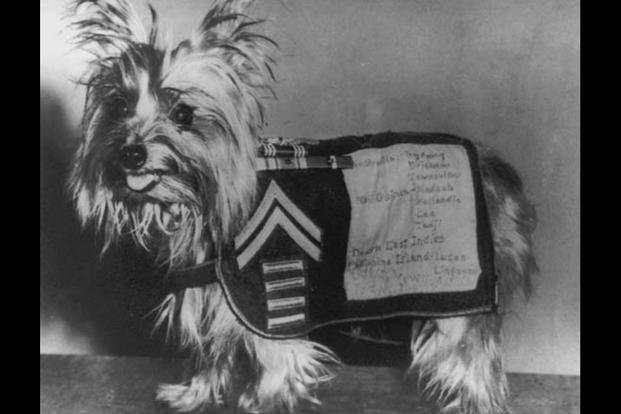
Working dogs are an integral part of modern military life, but dogs have been accompanying humans into combat since before recorded history.
Alexander the Great’s dog, Peritas, took down a charging elephant. An unnamed Newfoundland rescued Napoleon during his escape from exile on the Isle of Elba. The Dog of Robert the Bruce (yes that Robert the Bruce) defended the Scottish King from English troops.
Here are five more pups whose bravery is awe-inspiring:
1. Stubby

The war dog of war dogs, this American Pit Bull Terrier was found as a stray on the Yale campus in 1917 and smuggled to France during World War I by his adoptive owner, Cpl. John Robert Conroy.
Stubby served with the 102nd Infantry Regiment in the trenches in France for 18 months and participated in 17 battles. He used his keen senses to warn his unit of poison-gas attacks, incoming artillery fire, and to locate downed soldiers on the battlefield. He was promoted to sergeant – the highest rank achieved by a military animal at that time – after sniffing out a German spy in the trenches.
Sgt. Stubby was wounded in the foreleg by retreating Germans throwing hand grenades, and was also injured in Mustard Gas attacks. Because of that he was issued his own, specially designed, gas mask.
His handler smuggled him home after the war. Soon after, he met Presidents Woodrow Wilson, Calvin Coolidge, and Warren G. Harding. In 1921, General John J. Pershing presented a gold medal from the Humane Education Society to Stubby. Stubby died in 1926.
2. Chips

Chips was a Collie–German Shepherd–Siberian Husky mix whose owner donated him for duty during World War II. He was trained as a sentry dog and deployed with the 3rd Infantry Division in North Africa, Sicily, Italy, France and Germany. Later that year, during the invasion of Sicily, Chips and his handler were pinned down on the beach by an Italian machine-gun team.
Chips broke from his handler and jumped into the pillbox, attacking the gunners, which caused them to surrender. In the fight he sustained a scalp wound and powder burns. Later that day, he helped take 10 Italians prisoner.
Chips was awarded the Distinguished Service Cross, Purple Heart, and Silver Star for his actions, but unfortunately, the commendations were revoked as military policy at the time didn’t allow such recognition for animals. Chips was discharged in 1945 and returned to his original family, who in turn gave Chips to his military handler, Pvt. John P. Rowell.
3. Kaiser

Kaiser was a German Shepherd and one of 4,000 dogs who served in the Vietnam War. His handler was Marine Lance Cpl. Alfredo Salazar. Kaiser and Salazar did more than 30 combat patrols and participated in twelve major operations together.
After they joined “D” Company for a search-and-destroy mission, they were ambushed by the Viet Cong while on patrol in 1966. Kaiser was hit in the initial contact and died while trying to lick Salazar’s hand. Kaiser was the first war dog killed in action during Vietnam.
4. Nemo

On December 4, 1966, Nemo and Airman 2nd Class Bob Thorneburg were on patrol near an airbase in Vietnam when they suddenly came under concentrated enemy fire. Nemo took a round to his eye while Throneburg was shot in the shoulder after killing two Viet Cong guerillas.
Nemo viciously jumped at the enemy, giving Throneburg time to call in reinforcements. After Throneburg fell unconscious, Nemo crawled on top of his body to protect him. The dog didn’t let anyone touch his handler, and a veterinarian had to sedate Nemo so medics could attend to Thorneburg. Both survived, and Nemo lived until 1972.
5. Smoky

The unlikely hero at four pounds and seven inches long, the Yorkshire Terrier was initially found in February 1944 after being abandoned in a foxhole in New Guinea. The dog was purchased by Corporal William A. Wynne of Cleveland, Ohio, who backpacked with Smoky all over the Pacific Campaign, both living on a diet of C-rations and spam.
Smoky was a trooper, even running on coral ground for months, without developing health issues. Smoky Served in the South Pacific with the 5th Air Force, 26th Photo Recon Squadron and flew 12 rescue and photo reconnaissance missions. Smoky was credited with twelve combat missions and awarded eight battle stars.
She survived 150 air raids on New Guinea and made it through a typhoon at Okinawa. Smoky even parachuted from 30 feet in the air, out of a tree, using a parachute made just for her. Wynne credited Smoky with saving his life by warning him of incoming shells on an LST, calling her an “angel from a foxhole.”
On the Philippine Island of Luzon, she pulled a telegraph wire through a narrow 70-foot pipe, saving construction time and keeping workers and engineers safe from enemy fire. She died in 1957 at the age of 14.





